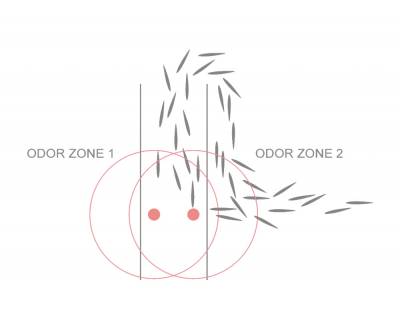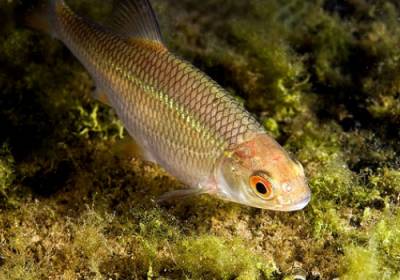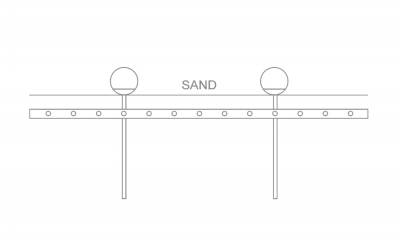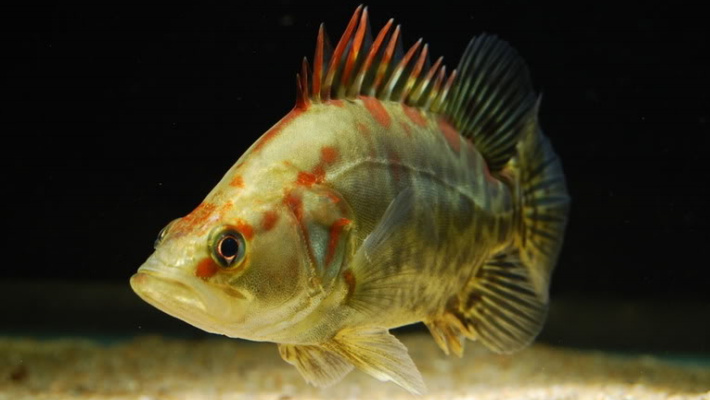|
Numerous manufacturers of baits for carp, bream and other cyprinid fish often include original
Robin Red in their products (pellets, boilies, pop-ups, groundbaits).
Robin Red is known as an attractor
and nutritional food product for carp and other cyprinid fish since 1950s. The active
ingredients in Robin Red include blended peppers, sugars, selected food oils
and blended spices. There is only one genuine, authentic and original Robin Red
that comes from Haith's Company, United Kingdom.
For
decades, Robin Red is considered as an undeniable ingredient of fish baits: its
effectiveness is taken for granted, not qualified or verified. However, our field tests with young roach, Rutilus rutilus, as model fish do not
educe an admitted effectiveness of Robin Red and related products.

Fig.1 (read text)
Field experiments
were usually conducted in river bays on the sandy shallows (20-30 cm depth)
near the shore using the two portable guiding net (10 mm mesh) wings (1.2-1.5 m
length, 20-30 cm height), with small foam floats and brass sinkers, that were
stretched between the two stainless steel pegs perpendicular to the shore (see
Fig 1). Roach (usually, from 4-5 to 10-12 cm length) that moved along the shore
faced one of the wings, avoided it, entered the corridor (35 cm width) between
the two wings and found, near the shore, the two clay balls (at the distance of
25 cm from their centers) that formed Odor Zone 1 and Odor Zone 2 to choose
from (see Fig.1).

Common roach, Rurilus rutilus
Other mass
bentivorous fish, such as young bream, Abramis
brama, and young white bream, Blicca
bjoerkna, were also used as model fish in these experiments.
Direct
field experiments with young carp are difficult, because hatchery ponds usually have
not suitable shallows.
To provide constantly
the same distance between the clay balls (shown conventionally as red spots in
Fig.1), they were placed on the adjustable cup-like pedestals of the brass frame
(Fig.2) hidden in the sand. 
Fig.2 (read text)
Compared mixes
were prepared of pure dry clay (90 or 100 gr per one ball, plus 10 or 1 gr of
attractant) and the corresponding attractants. Moist mixes were rolled in the balls
that had the same color (grey), shape (sphere) and size (2.0-2.5 cm radii
depending on the density of clay).
To ensure
exactly the same color of the balls, sometimes they were powdered with the
sand.
In the
capacity of standard attractant, one of our Unificated Feeding Attractants
(UFA) was used in experiments. This four ingredient attractant, that is marked
as UFA F4 and includes equal parts of squashed live sludgeworms, Tubifex tubifex, zebra mussels, Dreissena polymorpha (without shells), sideswimmers,
Gammarus pulex, as well as water larvae
of insects, mainly bloodworms, Chironomus
plumosus, is very strong for feeding-odor guided fresh (F) water fish
(Cyprinidae, Percidae, Cobitidae, Siluridae, etc.). One gram of this
attractant, with 0.25 gr of each ingredient, was mixed with 100 gr of pure dry clay.
This
attractant with the same or related feeding organisms and its ingredients are
widely used in scientific research.
As the
compared attractant, Robin Red Carp Pellets manufactured by Dynamite Baits
Company, United Kingdom,
were used. Dynamite Baits is an approved company that uses Haith's Company products. The
concrete nature of active ingredients in Robin Red (see above) and their
amounts are unknown. According to Dynamite Baits, Robin Red Carp Pellets are enhanced with amino acids and
proteins. The concrete composition of Robin Red Carp Pellets is also unknown.
To balance, in all our experiments 10 gr of powdered dry carp pellets were
mixed with 90 gr of pure dry clay.
In the first
experiment, 6 tests with the left position of one of the compared balls and 6
tests with the right position of the same ball were made. For statistical
estimations with use of the sign test (+ or –), an observer fixed visually the
first touch (the first touch test) of roach to Ball1 or Ball 2.
Findings given
in the Table show that in the first presentation tests roach ignored an odor of
Robin Red Carp Pellets. In our case, n =12, z fact =11, z standard
= 11, p < 0.01. As seen, roach touched clay balls with 10 gr of powdered Robin
Red Carp Pellets only 1 time of the 12 possible.
Ball
presentation
number
| Robin Red Carp Pellets
10 gr per 90 gr clay
| UFA F4
1 gr per 100 gr clay
| 01
| -
| +
| 02
| -
| +
| 03
| -
| +
| 04
| -
| +
| 05
| -
| +
| 06
| -
| +
| 07
| -
| +
| 08
| -
| +
| 09
| -
| +
| 10
| -
| +
| 11
| +
| -
| 12
| -
| +
|
Moreover,
roach willingly nibbled clay balls with UFA F4, but not balls with carp
pellets. In final sum,
the same results were
obtained in several (11) other sessions in other test localities. To the
point, roach preferred balls with 1 gr of bloodworms over balls with 10 gr of
carp pellets.
It is known
that all active ingredients included in commercial Robin Red and related Robin
Red Carp Pellets are attractive for fish. For comparison, acrid black and white
peppers, Piper nigrum (Piperaceae),
and some other spices attract oriental weatherfish, Misgurnus anguillicaudatus, and yellowtail, Seriola quinqueradiata (Harada, 1990). According to Venkateshwarlu et al. (2009), kakla
pepper, Piper cubela (from the same
family Piperaceae), is more attractive for South-East Asian rohu, Labeo rohita (Cyprinidae), than
commercial betaine. But it does not mean that naturally odd odors of Robin Red
and Robin Red Carp Pellets must beat odors familiar for fish.
Natural
feeding attractants are based on feeding organisms that are familiar for fish
in water bodies with common, middle and even strong angling pressure. These
attractants are ethologically grounded, they start to work instantly. On the
contrary, carp pellets, boilies and related products are rather nutritionally
based. In natural water bodies, you must spend several days of regular groundbaiting
to habituate fish to frequently unusual odors of these products.
In water
bodies with strong angling pressure, the effectiveness of carp pellets, boilies
and related products are dependent on the pre-history (usually unknown) of groundbaiting
and pre-baiting. After exposing research conducted by Richard Arlinghaus with
co-authors (e.g., Arlinghaus & Niesar, 2005), declarated nutritional values
of these products must be put under the deep doubts.
Basic
References
Arlinghaus
R., Niesar M. 2005. Nutrient degestibility of angling baits for carp, Cyprinus carpio, with implications for
groundbait formulation and eutrophication control. Fisheries Management & Ecology 12, 91-97
Harada K.
1990. Attraction activities of spices for oriental weatherfish and yellowtail. Nippon Suisan Gakkaishi 56, 2029-2033
Venkateshwarlu
G., Muralidhar A. P., Rathod R., Pal A. K. 2009. Plants traditionally used in
fish harvest & angling potential feed attractants in aquaculture. Indian Journal of Traditional Knowledge
8, 539-542
|








 SUBSCRIBE
SUBSCRIBE





